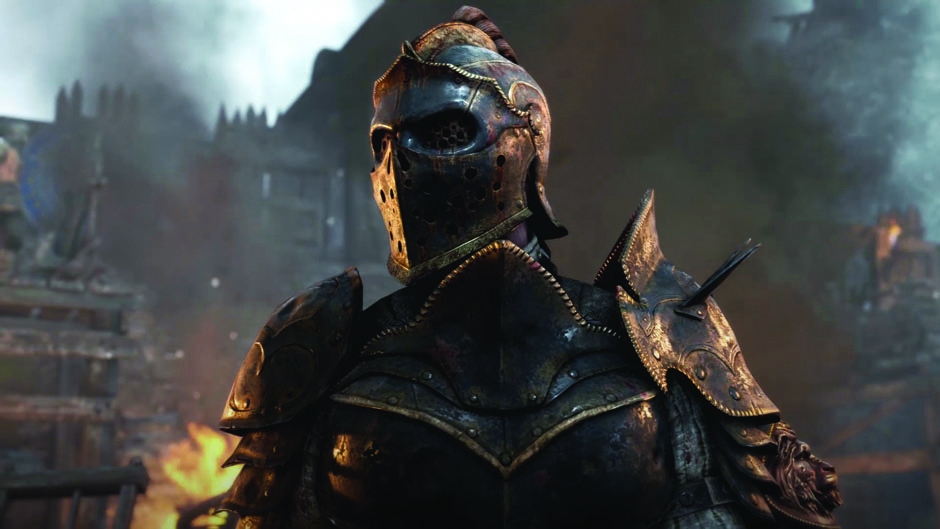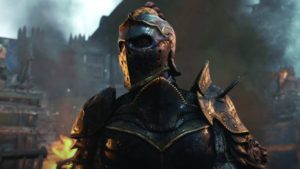

The game’s story mode switches between three different characters, representing the three factions (knights, vikings and samurai) as they battle main villain Warlord Apollyon (above), who seeks to create perpetual war across the world with her knight army.
By Grant Stoner | Staff Writer
My Warden patiently waits on the decrepit wooden bridge for his opponent. Suddenly, a Berserker charges, angrily swinging his sword to the right. My Warden predicts the strike, effortlessly blocking the blow before performing an overhead swing, causing the once bloodthirsty savage to collapse in a cloud of dust. With “For Honor,” patience and precision are key when playing this exhilarating action title. However, connectivity issues prevent this otherwise thrilling title from achieving its full potential.
Developed and published by Ubisoft, known for games such as the “Assassin’s Creed” and “Far Cry,” “For Honor” captures the intensity of close-quartered-combat. Knights, Vikings and Samurai clash for supremacy in this utterly confusing mashup of characters. Yet despite the logistics of the lore, I have never enjoyed myself more when it comes to combat mechanics and enemy encounters.
In the story mode, “For Honor” does little to explain the dynamics of the three factions, or why they continuously fight. In fact, during the introduction scene, the narrator states that the true origin of the conflict has been lost to time. However, the campaign mode provides an excellent tutorial for each of the 12 character classes. Through the relatively short missions, the playstyle for each hero is effectively explained assists players with the game’s multiplayer component.
Each duel is an exceptional combination of strategy and skill. Blindly mashing the light and heavy attack buttons will do nothing but quickly drain your stamina and leave you wide open for attacks. Upon finding a worthy opponent, players enter into a stance known as “Guard Mode.” In this position, three directional bars appear in front of each warrior, indicating which way to block and swing. As you or your enemy wind up for an attack, one of the bars will turn red, notifying each gamer about the move. Parrying, guard-breaks and stylish executions can also be incorporated into each fight, providing even more techniques to honorably crush your foe. Furthermore, each warrior can tap into a “Revenge Mode,” which greatly boosts their offense and defensive capabilities. After blocking a specific amount of damage, players can press a button, which temporarily empowers their hero, often turning them into an unstoppable force of destruction. Successfully taking down three foes in “Revenge Mode,” coupled with other abilities, is an immensely satisfying feeling.
Multiplayer modes such as “Dominion,” “Elimination,” “Duel” or “Brawl” are where players can truly test their skills against one another. Team-based modes like “Dominion” require warriors to combine their efforts to eliminate opponents and capture objectives. “Duel” offers a more intimate fight with a single enemy, where players clash in a best-of-five rounds scenario. “Dominion” and “Elimination” are where I spent the majority of time. If an opponent became too difficult to fight, I could easily transition to another enemy, or focus on capturing objectives.
Unfortunately, multiplayer is nowhere near as polished as the other mechanics. Throughout my playthrough, I consistently encountered network connectivity issues, as well as players disconnecting from matches. In fact, my friend could rarely connect with me when selecting “Dominion,” forcing us to abandon a third of the multiplayer experience. Rather than discuss battle strategies in lobbies, my friend and I would regularly worry if we needed to back out in order to send another invite.
If you are able to play through an entire match, gamers are rewarded with various pieces of equipment which can significantly alter specific stats for each hero. Armor pieces can provide better defense, quicker stamina recovery or the ability to enter “Revenge Mode” faster. As for weapons, upgrades consisting of more damage, reduced stamina loss when blocking or the ability to quickly revive teammates can be discovered. Even though the equipment can help, fights are ultimately decided through skill. If anything, these rewards serve for aesthetic purposes only.
“For Honor” is almost perfect. I have never played a game where the combat is so precise and fulfilling. Each strike, block and roll is intuitive, always responding to my exact command. Yet, with a myriad of connectivity issues, “For Honor” can easily turn into a frustrating game.



